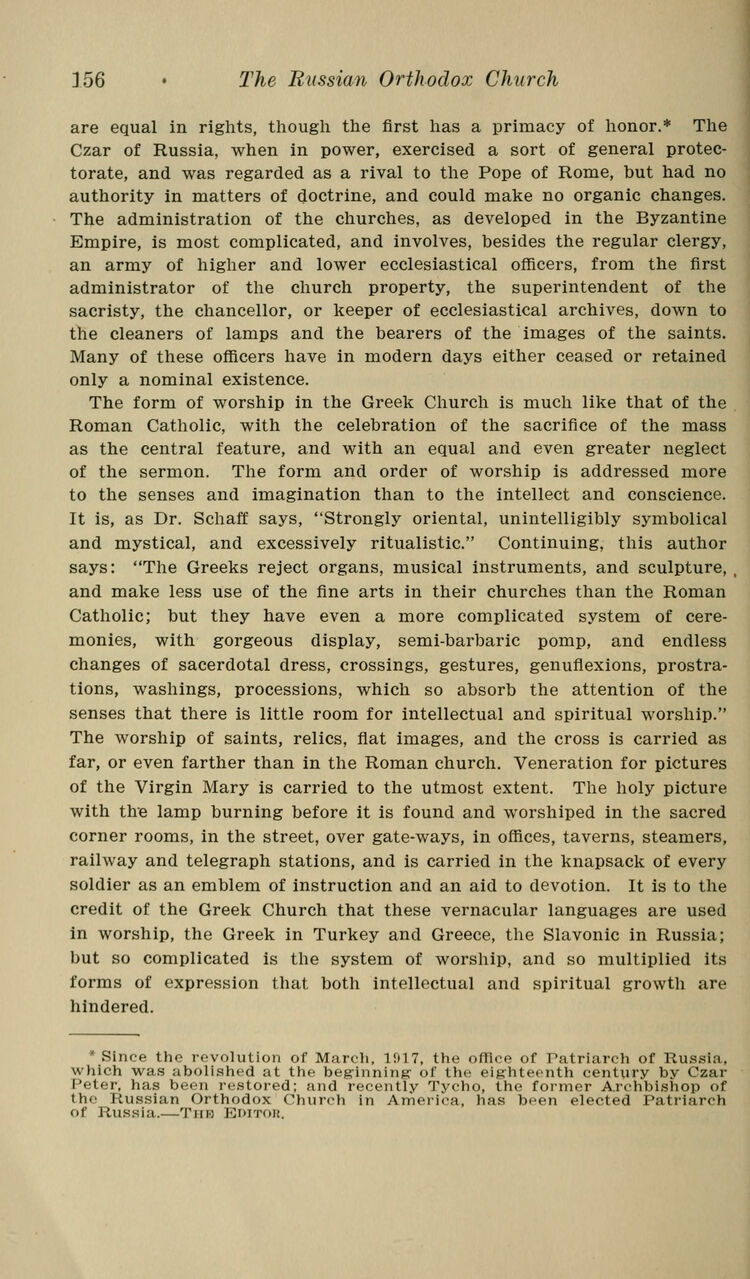
Full resolution (JPEG) - On this page / på denna sida - The Russian Orthodox Church. The Rev. Robert M. Russell, D. D., LL. D. - Government and Worship

<< prev. page << föreg. sida << >> nästa sida >> next page >>
Below is the raw OCR text
from the above scanned image.
Do you see an error? Proofread the page now!
Här nedan syns maskintolkade texten från faksimilbilden ovan.
Ser du något fel? Korrekturläs sidan nu!
This page has never been proofread. / Denna sida har aldrig korrekturlästs.
]56 •
The Russian Orthodox Church
are equal in rights, though the first has a primacy of honor.* The
Czar of Russia, when in power, exercised a sort of general protec-
torate, and was regarded as a rival to the Pope of Rome, but had no
authority in matters of doctrine, and could make no organic changes.
The administration of the churches, as developed in the Byzantine
Empire, is most complicated, and involves, besides the regular clergy,
an army of higher and lower ecclesiastical officers, from the first
administrator of the church property, the superintendent of the
sacristy, the chancellor, or keeper of ecclesiastical archives, down to
the cleaners of lamps and the bearers of the images of the saints.
Many of these officers have in modern days either ceased or retained
only a nominal existence.
The form of worship in the Greek Church is much like that of the
Roman Catholic, with the celebration of the sacrifice of the mass
as the central feature, and with an equal and even greater neglect
of the sermon. The form and order of worship is addressed more
to the senses and imagination than to the intellect and conscience.
It is, as Dr. Schaff says, "Strongly oriental, unintelligibly symbolical
and mystical, and excessively ritualistic." Continuing, this author
says: "The Greeks reject organs, musical instruments, and sculpture,
and make less use of the fine arts in their churches than the Roman
Catholic; but they have even a more complicated system of cere-
monies, with gorgeous display, semi-barbaric pomp, and endless
changes of sacerdotal dress, crossings, gestures, genuflexions, prostra-
tions, washings, processions, which so absorb the attention of the
senses that there is little room for intellectual and spiritual worship."
The worship of saints, relics, flat images, and the cross is carried as
far, or even farther than in the Roman church. Veneration for pictures
of the Virgin Mary is carried to the utmost extent. The holy picture
with the lamp burning before it is found and worshiped in the sacred
corner rooms, in the street, over gate-ways, in offices, taverns, steamers,
railway and telegraph stations, and is carried in the knapsack of every
soldier as an emblem of instruction and an aid to devotion. It is to the
credit of the Greek Church that these vernacular languages are used
in worship, the Greek in Turkey and Greece, the Slavonic in Russia;
but so complicated is the system of worship, and so multiplied its
forms of expression that both intellectual and spiritual growth are
hindered.
’Since the revolution of Marcli, 1017, the office of Patriarch of Russia,
which was abolished at the beg-inning: of the eigrhteonth century by Czar
Peter, has been restored; and recently Tycho, the former Archbishop of
the Russian Orthodox Church in America, has been elected Patriarch
of Russia.—TiiK EniTon.
<< prev. page << föreg. sida << >> nästa sida >> next page >>